L 3 Communications Avionics Systems TRC899 User Manual Chapter2
L-3 Communications, Avionics Systems Chapter2
Contents
- 1. User Manual 1 of 2
- 2. User Manual 2 of 2
- 3. Install Manual
User Manual 1 of 2
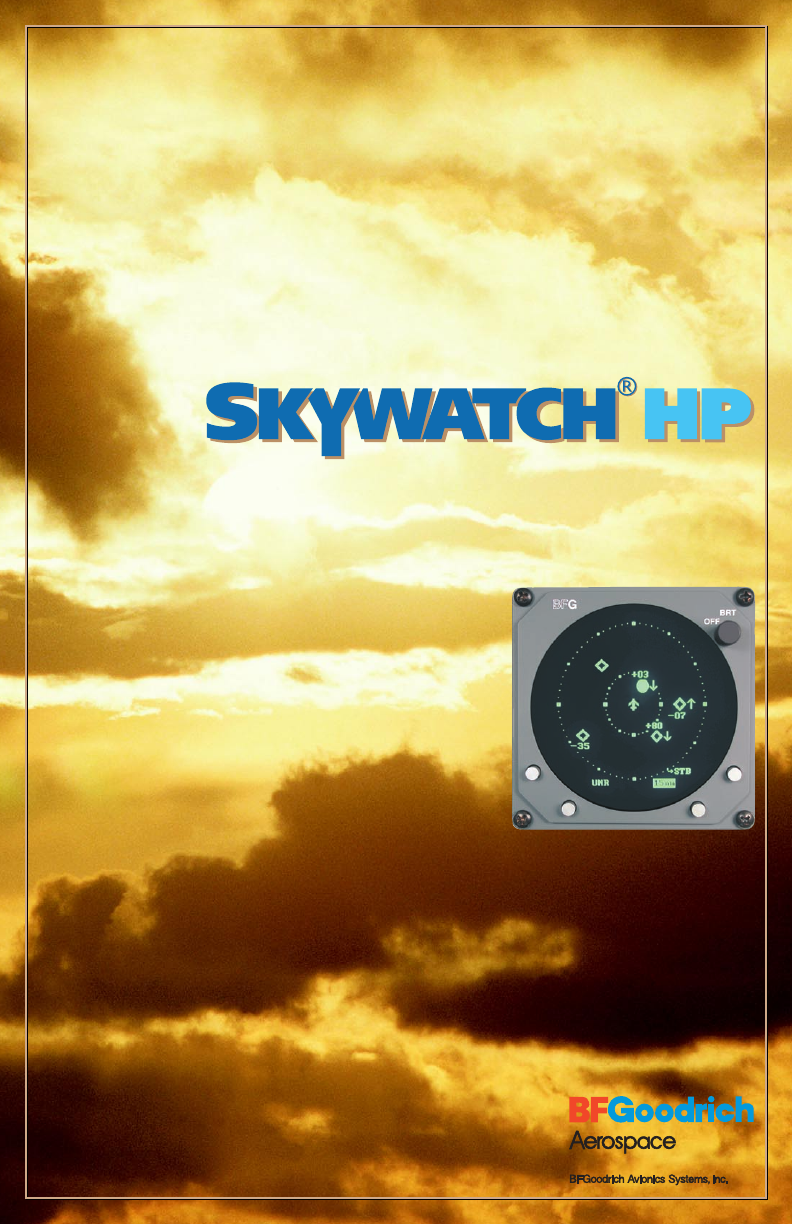
Preliminary
$12.00 U.S.
$12.00 U.S.
Pilot’s Guide
for the
Pilot’s Guide
for the
Traffic Alert/Advisory System
Model SKY899
Traffic Alert/Advisory System
Model SKY899

SKY899 Pilot’s Guide
A
Preliminary
Eyes That Never Blink™
Early Traffic Alert/Advisory Systems
In the early days of flight, pilots were equipped with all they
needed for effective collision avoidance–a sharp pair of eyes.
But increasing traffic at higher speeds led to the development
of TCAS I and II (Traffic Alert and Collision Avoidance Systems)
which were too expensive for most regional airlines, business
aircraft, and general aviation aircraft.
SKYWATCH®
BFGoodrich Avionics Systems, Inc. recognized the need for an
alternative to expensive TCAS systems and developed the
SKYWATCH model SKY497 Traffic Advisory System (TAS) and
the SKYWATCH HP model SKY899 TAS/TCAS I.
The SKYWATCH HP can be installed as a TAS to provide most
of the capabilities of TCAS I, but at a significantly lower cost,
making it practical for small aircraft. The SKYWATCH HP can
also be installed as a TCAS I.
In addition to its TCAS I capability, SKYWATCH HP improves
upon the SKY497 by adding ADS-B surveillance, a larger display
range (15 nmi), and a higher maximum closure rate (1200 kn).
Proven Experience
BFGoodrich Avionics Systems, Inc. has been involved in the
development of collision warning programs since the early
1980’s. In 1985, BFG began development of an enhanced
collision warning system for the Navy’s T-34C training aircraft.
Based largely on the success of the Navy project, BFG was
selected to validate the specifications for TCAS I. As a result,
BFG’s original TCAS I unit, the TCAS791 was the first TCAS I to
be TSO’d, first to receive a full, unrestricted STC, first to fly,
and first to be delivered.

Preliminary
$12.00 U.S.
Pilot’s Guide
for the
Traffic Alert/Advisory System
Model SKY899
© Copyright 2001
BFGoodrich Avionics Systems, Inc.
SKYWATCH
®
, EYES THAT NEVER BLINK
™
, and STORMSCOPE
®
are trademarks of
BFGoodrich Avionics Systems, Inc.
Designed and manufactured in the United States of America by
Methods and apparatus disclosed and described herein have been developed solely on company funds of BF-
Goodrich Avionics Systems, Inc. No government or other contractual support or relationship whatsoever has
existed which in any way affects or mitigates proprietary rights of BFGoodrich Avionics Systems, Inc. in these
developments. Methods and apparatus disclosed herein may be subject to U.S. Patents existing or applied for.
BFGoodrich Avionics Systems, Inc. reserves the right to add, improve, modify, or withdraw functions, design
modifications, or products at any time without notice.
BFGoodrich Avionics Systems, Inc.
5353 52nd Street, S.E.
Grand Rapids, MI 49512 USA
(616) 949-6600
Fax (616) 285-4224
www.bfgavionics.com
(800) 253-9525 or
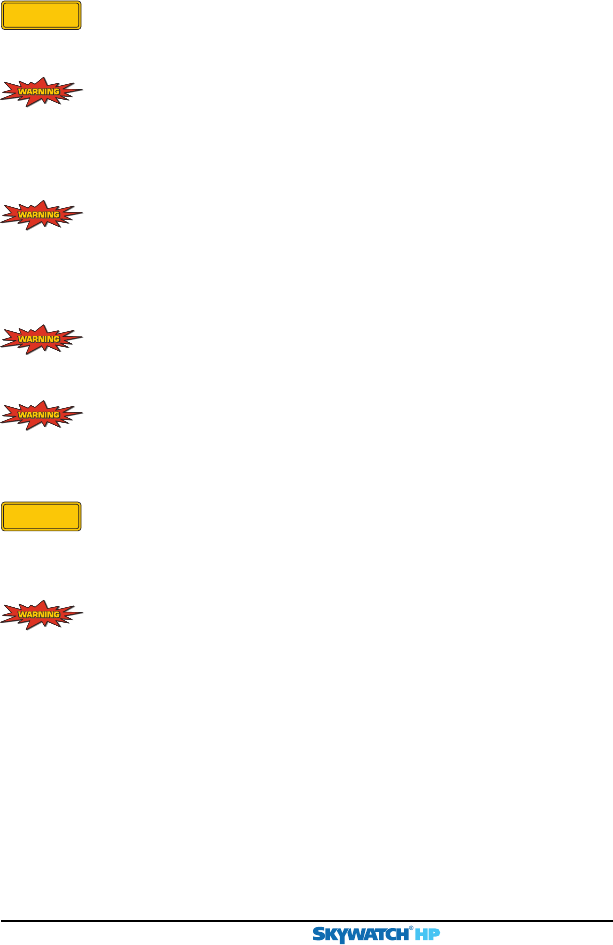
SKY899 Pilot’s Guide
ii
Preliminary
Safety Summary
These warnings and cautions appear later in this guide and are
repeated here for emphasis:
To avoid power surges that could damage the SKY899 and the
optional WX-1000, start your engines before turning on the SKY899.
If the SKY899 is in SKYWATCH mode, the display will not auto-
matically switch into Stormscope mode to display thunderstorms or
Stormscope errors. Use the remote SKYWATCH/Stormscope mode
switch to periodically check for thunderstorms or Stormscope errors.
The SKY899 relies on information obtained from transponders in
nearby aircraft. The SKY899 does not detect or track aircraft which
are not equipped with an operating Air Traffic Control Radar
Beacon System (ATCRBS) transponder.
The SKY899 does not track intruder aircraft approaching at a
closure rate greater than 1200 knots.
Some traffic within the chosen display range may not be displayed
due to traffic prioritizing, antenna shielding, or ground intruder
filtering.
Optimum SKY899 performance is realized when intruder aircraft
are reporting their altitude (via a mode C or other altitude
reporting transponder).
Do not attempt evasive maneuvers based solely on traffic informa-
tion on the display. Information on the display is provided to the
flight crew as an aid in visually acquiring traffic; it is not a
replacement for Air Traffic Control (ATC) and See & Avoid
techniques.
CAUTION
page 3-5
page 3-6
page 3-6
page 3-6
page 3-6
CAUTION
page 3-1
page 3-6

SKY899 Pilot’s Guide iii
Preliminary
Table of Contents
Section Page
List of Illustrations ....................................... v
List of Tables...............................................vi
Abbreviations & Acronyms............................ vii
Chapter 1, System Description ................... 1-1
General Description ................................................................... 1-1
Transmitter Receiver Computer (TRC)........................................ 1-2
Directional Antenna ................................................................... 1-2
Display ...................................................................................... 1-3
Interaction of Major Components ............................................... 1-4
Functional Description ............................................................... 1-4
Features ..................................................................................... 1-6
Chapter 2, Controls & Indicators ................. 2-1
Introduction .............................................................................. 2-1
Controls, Indicators, & Symbols ................................................. 2-1
Controls Required for the Stormscope Option ............................... 2-5
Controls & Indicators for an Alternate Display ............................. 2-6
Aural Announcements ................................................................ 2-6
Chapter 3, Operating Instructions ............... 3-1
Introduction .............................................................................. 3-1
Turn On the SKY899 ................................................................. 3-1
Run the Operator-Initiated Self Test ............................................ 3-3
Switch Between Standby & Normal Operating Mode ................... 3-3
Change the Display Range .......................................................... 3-4
Change the Vertical Display Mode ............................................... 3-5
Switch Between SKYWATCH & Stormscope .................................. 3-5
Observe the Display ................................................................... 3-6
Respond to Traffic Advisories ...................................................... 3-6
Turn Off the SKY899 and the Optional WX-1000 ....................... 3-7
Operate the WX-1000 Without the SKY899 ............................... 3-7
Operate the SKY899 Without the WX-1000 ............................... 3-7
Message Response ...................................................................... 3-7
Respond to a Failed System .................................................... 3-7
Respond to a Degraded System .............................................. 3-9

SKY899 Pilot’s Guide
iv
Preliminary
Section Page
Table of Contents (continued)
Chapter 4, Principles of Operation ............... 4-1
Introduction .............................................................................. 4-1
Sensitivity Levels ........................................................................ 4-1
Sensitivity Level A ................................................................. 4-1
Sensitivity Level B ................................................................. 4-3
Audio Inhibit, SKY899 ............................................................... 4-5
Audio Inhibit, GPWS, EGPWS, or TAWS ................................... 4-5
TA Symbol Duration .................................................................. 4-6
Ground Intruder Filtering ........................................................... 4-6
ADS-B ...................................................................................... 4-6
Chapter 5, Display Interpretation ................ 5-1
Introduction .............................................................................. 5-1
Chapter 6, Specifications ........................... 6-1
Chapter 7, Warranty Information ................ 7-1
Introduction .............................................................................. 7-1
Warranty Statement.................................................................... 7-1
Related Policies and Procedures ................................................... 7-2

SKY899 Pilot’s Guide v
Preliminary
List of Illustrations
Figure Title Page
1-1 SKY899 Major Components .............................................................. 1-1
1-2 Display with Typical SKYWATCH HP Screen .................................... 1-3
1-3 Display with Typical Stormscope Screen (Optional) ............................. 1-3
1-4 System Block Diagram ....................................................................... 1-5
1-5 Vertical Display Modes and Traffic Zones ............................................ 1-7
2-1 Controls & Screen Elements in Standby .............................................. 2-1
2-2 Controls & Screen Elements in Operating Mode ................................. 2-2
2-3 Vertical Display Mode Indicator Lamps............................................... 2-6
3-1 BFGoodrich Screen ........................................................................... 3-1
3-2 Standby Screen .................................................................................. 3-2
3-3 In-Flight Traffic Screen ....................................................................... 3-2
3-4 Failed Screen ..................................................................................... 3-2
3-5 Test Screen ........................................................................................ 3-3
3-6 Traffic Screen on the Ground.............................................................. 3-4
3-7 Display Ranges .................................................................................. 3-4
3-8 Message Screen with Two Messages ..................................................... 3-9
3-9 Message Screen with No Messages .................................................... 3-10
4-1 TA Zones If Your Aircraft Has a Radio Altimeter .................................. 4-4
4-2 TA Zones If Your Aircraft Has No Radio Altimeter, But Does Have a
Retractable Landing Gear ................................................................... 4-4
4-3 TA Zones If Your Aircraft Has No Radio Altimeter
and a Fixed Landing Gear................................................................... 4-5
4-4 ADS-B ............................................................................................. 4-6
5-1 TA & OT on 15 nmi Range, UNR Mode ........................................... 5-1
5-2 Other Traffic on 15 nmi Range, UNR Mode ....................................... 5-2
5-3 Other Traffic on 6 nmi Range, NRM Mode......................................... 5-2
5-4 TA & OT on 2 nmi Range, BLW Mode .............................................. 5-2
5-5 Off-Screen TA on 2 nmi Range, ABV Mode ........................................ 5-3
5-6 Standby Screen .................................................................................. 5-3
5-7 Failed Screen ..................................................................................... 5-3

SKY899 Pilot’s Guide
vi
Preliminary
4-1 Fourteen Situations in Which a Traffic Advisory Will Occur ................. 4-2
6-1 TRC899 Specifications ...................................................................... 6-1
6-2 BFG WX-1000/SKY497 Display Specifications .................................. 6-3
6-3 NY164 Directional Antenna Specifications
(for TAS installations only) ................................................................. 6-4
6-4 NY156 Directional Antenna Specifications
(
required for TCAS I installations, optional for TAS
)............................... 6-4
Table Title Page
List of Tables

SKY899 Pilot’s Guide vii
Preliminary
Abbreviations & Acronyms
ABV Above
Ack Acknowledge
ADS-B Automatic Dependent Surveillance-Broadcast
AFM Aircraft Flight Manual
AFS Flight Standards Service
AGL Above Ground Level
AHRS Attitude and Heading Reference System
Alt Altitude
ARINC Aeronautical Radio, Inc.
ATC Air Traffic Control
ATCRBS Air Traffic Control Radar Beacon System
ATI Air Transport Indicator
ATM Air Traffic Management
BFG BFGoodrich
BFGAS BFGoodrich Avionics Systems, Inc.
BLW Below
Comm Communication
CPA Closest Point of Approach
CRT Cathode Ray Tube
EFIS Electronic Flight Instrument System
EGPWS Enhanced Ground Proximity Warning System
FAA Federal Aviation Administration
fpm Feet Per Minute
FSAW Flight Standards Information Bulletin for
Airworthiness
GPS Global Positioning System
GPWS Ground Proximity Warning System
Grnd Ground
HP High Performance
I/O Input/Output
IVSI Instantaneous Vertical Speed Indicator
kn Knots
MFD Multi-Function Display
Mod Modification

SKY899 Pilot’s Guide
viii
Preliminary
Abbreviations & Acronyms (continued)
MSG Message
Nav Navigation
nm Nautical Miles (on the display)
nmi Nautical Miles (in the text)
NRM Normal
OPR Operate
OT Other Traffic
PA Proximity Advisory
P/N Part Number
Rev Revision
RGC Radar Graphics Computer
RTCA Requirements & Technical Concepts for Aviation
SLA Sensitivity Level A
SLB Sensitivity Level B
SSR Secondary Surveillance Radar
STB Standby
TA Traffic Advisory
TAS Traffic Advisory System
TAWS Terrain Awareness and Warning System
TCAS Traffic Alert and Collision Avoidance System
TRC Transmitter Receiver Computer
TSO Technical Standard Order
UNR Unrestricted
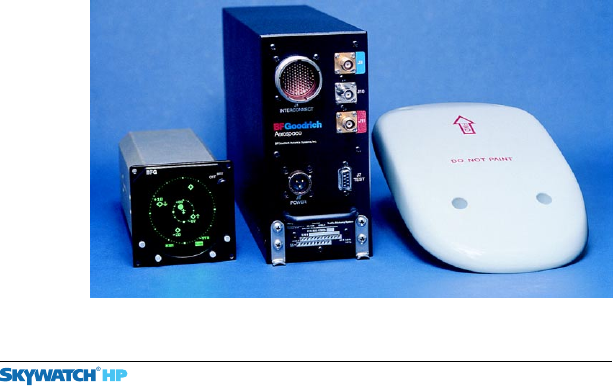
SKY899 Pilot’s Guide 1-1
Preliminary
System Description
Chapter 1
General Description
The SKYWATCH®HP Traffic Alert/Advisory System, model
SKY899, from BFGoodrich Avionics Systems, Inc. (BFG) can be
installed as a Traffic Alert and Collision Avoidance System I
(TCAS I) or as a Traffic Advisory System (TAS). In either
configuration, the SKY899 monitors the airspace around your
aircraft and advises the flight crew where to look for transpon-
der-equipped aircraft that may pose a collision threat. Traffic
information on the display generally includes the range, relative
bearing, and relative altitude of intruder aircraft. The SKY899
also makes aural announcements such as traffic advisories on
the cockpit audio system. The SKY899 is intended for use by
high performance corporate and general aviation aircraft.
Figure 1-1 shows the major components of the SKY899.
Figure 1-1. SKY899 Major Components
Directional Antenna
TRC
Display
This is the SKY497
picture. I will substitute
a picture of the SKY899
when the equipment is
ready to photograph.

Chapter 1 – System Description
SKY899 Pilot’s Guide
1-2
Preliminary
When installed as a TAS, the SKY899 can share a BFG model
WX-1000/SKY497 monochrome display (P/N 78-8060-5900-8 or -
9) with a BFG STORMSCOPE® model WX-1000 using a remote
SKYWATCH/Stormscope mode switch. As a TAS, the SKY899 can
also display traffic on a growing number of Multi-Function
Displays (MFDs) and Electronic Flight Instrument System
(EFIS) displays from companies such as Avidyne, Garmin, and
Collins, or on select Instantaneous Vertical Speed Indicators
(IVSIs) from Honeywell or Sextant, or on a compatible weather
radar indicator via the BFG Radar Graphics Computer, model
RGC250. Check with your dealer or with BFG for a current list
of approved alternate displays.
When installed as a TCAS I, the SKY899 displays its traffic
information on a TCAS I-compatible alternate display as de-
scribed above, but not on the WX-1000/SKY497 display.
Hereafter the word display refers to the WX-1000/SKY497
display unless otherwise indicated. For any other display, refer
to that display’s manual for a description of how it displays
SKY899 traffic information.
Transmitter Receiver Computer (TRC)
The TRC is the primary unit of the SKY899. It converts signals
from the directional antenna and from other aircraft systems
into an on-screen picture of intruder aircraft locations, and if
necessary, aural traffic advisories. The TRC can track up to 35
intruder aircraft simultaneously, but to reduce clutter, the
SKY899 only displays the 8 most threatening intruders being
tracked. The TRC also has built-in test equipment to detect
faults and to verify proper operation.
Directional Antenna
The directional antenna transmits omnidirectional mode C
interrogations and receives directional replies from other
transponder-equipped aircraft in the vicinity. The antenna also
receives Automatic Dependent Surveillance-Broadcast (ADS-B)
mode S extended squitter broadcasts from intruder aircraft.
TRC & Antenna
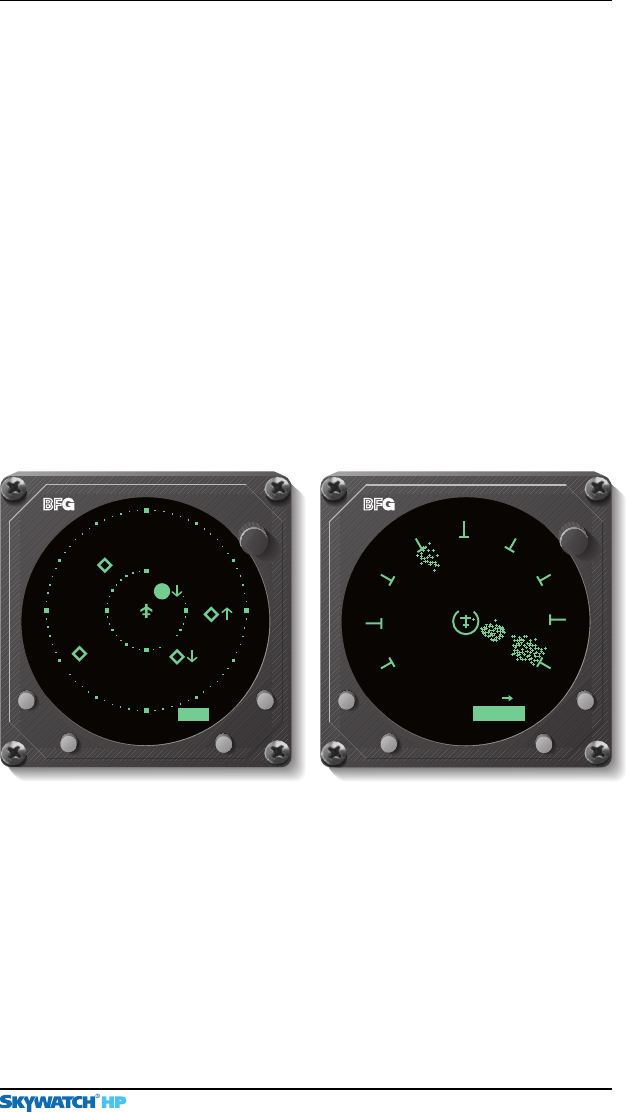
Chapter 1 – System Description
SKY899 Pilot’s Guide 1-3
Preliminary
Display
The display is a 3-inch Air Transport Indicator (3-ATI) unit
with a high resolution, green monochrome Cathode Ray Tube
(CRT) display. The bezel contains four momentary contact
push-button switches and an on/off/brightness knob. The
display provides control and display functions for the SKY899
(installed as a TAS) and for a WX-1000 Stormscope (if installed).
The display does not display traffic and storm information
simultaneously. The position of a remote SKYWATCH/
Stormscope mode switch determines whether the display shows
traffic or storm information; however, if you’re in Stormscope
mode and the SKY899 detects traffic that may pose an immedi-
ate threat to your aircraft, the display temporarily switches to
SKYWATCH mode. Figure 1-2 shows the display with a typical
SKYWATCH HP screen. Figure 1-3 shows the display with a
typical Stormscope screen.
Display
Figure 1-3. Display with Typical
Stormscope Screen (Optional)
Figure 1-2. Display with Typical
SKYWATCH HP Screen
BRT
OFF
UNR 15nm
-07
-35
+03
+80
MENU
CLEAR
120°
25
200 nm
BRT
OFF

Chapter 1 – System Description
SKY899 Pilot’s Guide
1-4
Preliminary
Interaction of Major Components
Interaction of Major Components
Figure 1-4 shows how the major components of the SKY899
connect to each other and to other aircraft systems.
Notes on Figure 1-4:
1. The optional radio altitude input affects the SKY899 audio
inhibit feature, the ground intruder filtering feature, and
the sensitivity levels feature. (See chapter 4 for details.)
2. GPS nav data is only required if you plan on using
SKY899’s ADS-B feature (for intruder location enhance-
ment).
3. The SKY899 works without a heading input, but experi-
ences degraded performance during high-rate-of-turn
maneuvers.
4. Having a weight-on-wheels input allows the SKY899 to
automatically switch out of standby when you take off,
and into standby when you land.
5. The SKY899 may be installed on aircraft with fixed landing
gear. The optional landing gear position input affects the
sensitivity levels feature. (See chapter 4 for details.)
6. The RGC250/radar indicator or alternate display can be in
place of, or in addition to the WX-1000/SKY497 display for
TAS installations, but one of the two must be used for
TCAS I installations.
7. Only required when using an alternate display that doesn’t
display vertical display mode indications.
Functional Description
The SKY899 is an active system that operates as an aircraft-to-
aircraft interrogation device. The SKY899 interrogates aircraft
transponders in the surrounding airspace (within a 35 nmi
horizontal radius) similar to the way ground-based radar
interrogates aircraft transponders. When the SKY899 receives
replies to its interrogations, it computes the responding
aircraft’s range, relative bearing, relative altitude, and closure
rate. The SKY899 also receives any ADS-B broadcasts from the
responding aircraft and uses that information along with your
own aircraft Global Positioning System (GPS) navigation (nav)
data to enhance the computed relative position of the respond-
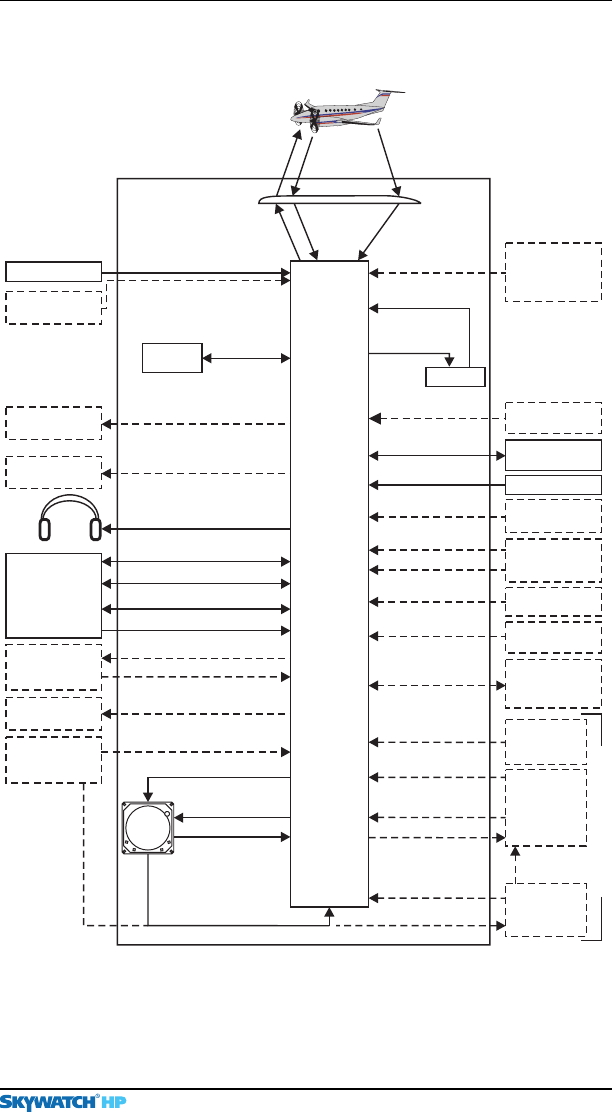
Chapter 1 – System Description
SKY899 Pilot’s Guide 1-5
Preliminary
System Block Diagram
Figure 1-4. System Block Diagram
Aircraft
Audio
System
Aircraft Power
Auxiliary Serial Data (RS-422)
Auxiliary Serial Data (RS-232)
Auxiliary ARINC 429 RX Data
Bi-directional Discrete I/O
SKYWATCH
Display (ARINC 429)
SKYWATCH
Display (ARINC 429)
SKYWATCH
Control
SKYWATCH
Control (ARINC 429)
Barometric Altitude
ABV & BLW
Indicator Lamp Outputs
Discrete Lamp Control
System Software
Updates
Diagnostic
Commands and
Status (RS-232)
Flight Data
&System
Configuration
Configuration
Settings
Radio Altimeter or
Flight Data
Computer
(Optional)
SKYWATCH/
Stormscope
Mode Switch
Future
Enhancements
Alternate Display
(Optional)
6
Control Panel for
use with Alternate
Display (Optional)
BFG RGC250/
Radar Indicator
(Optional)
6
Encoding Altimeter
Diagnostic
Equipment e.g.
Laptop (Optional)
ABV & BLW
Indicator Lamps
7
Operate Lamp
(Optional)
Air Data Computer
(Optional)
Squat Switch
(Optional)
GPWS/TAWS
(Optional)
Personality
Plug
Landing Gear
Switch (Optional)
WX-1000
Processor
Stormscope
WX-1000
Maintenance
Switch
Synchro XYZ
Compass, or
AHRS (Optional)
Aircraft
Suppression Bus
GPS Navigation
System (Optional)
Radio Altitude
1
SKYWATCH/
Stormscope
Mode Selection
SKYWATCH-
TAS or
Display
Stormscope
Stormscope
Display
TRC On/Off Control
When WX-1000 is
Powered Down or
Removed Override
Norm
WX-1000
On/Off Control
TRC On/Off Control
Display Power
TRC
SKYWATCH-
TAS or
Control
Stormscope
Stormscope
Control
On/Off Control
(with Option)
Stormscope
On/Off Control
Stormscope
Option
+28 V dc
Aural TA's & Other Audio Output
Magnetic Heading
Mag. Heading Valid
TX/RX Inhibit
GPS Nav Data
(ARINC 429)
Landing
Gear Position
Audio Inhibit
Weight On Wheels
WX-1000
Display
Directional
Antenna
SKY899
Intruder Aircraft
Flash Card
3
4
2
5
Transponder
Transponder
Interrogations
Interrogations
Replies
Replies
Transponder
Transponder
Broadcasts
Broadcasts
ADS-B Squitter
ADS-B Squitter

Chapter 1 – System Description
SKY899 Pilot’s Guide
1-6
Preliminary
Features
ing aircraft. The SKY899 then predicts collision threats and
plots the eight most threatening aircraft locations on the
display.
Figure 1-5 shows the SKY899 vertical display modes (look up,
look down, normal, and unrestricted). The figure also shows
the traffic zones around your aircraft and the traffic symbols
that appear on the display when intruding aircraft enter one of
those zones.
A solid circle is the visual part of the Traffic Advisory (TA) that
the SKY899 generates when it predicts that an intruder aircraft
may pose a collision threat. The aural part of the TA, “traffic,
traffic,” is annunciated over a cockpit speaker or headset. An
open diamond represents Other Traffic (OT) that does not pose
an immediate collision threat. A solid diamond (Proximity
Advisory, PA) only appears on TCAS installations.
The SKY899 uses either Sensitivity Level A (SLA) or Sensitivity
Level B (SLB) to determine when to display a TA. In general,
SLB is used during the in-flight phase and SLA is used during
takeoff and landing. Sensitivity levels and other factors affect-
ing the display of traffic symbols are discussed in detail in
chapter 4.
Features
•Tracks up to 35 intruder aircraft (displays the 8 most threat-
ening)
•Tracks intruder aircraft approaching at closure rates up to
1200 knots
•Installs as a TAS or as a TCAS I
•Costs only a fraction of the price of a traditional TCAS I or II
•Requires no mode S transponder
•Displays traffic information in three horizontal display
ranges: 15, 6, and 2 nmi
•Displays traffic information in four vertical display modes:
normal (±2,700 ft), look up (+9,000 ft to –2,700 ft), look down
(+2,700 ft to –9,000 ft), and unrestricted (±9,900 ft)
•Generates visual and aural advisories of aircraft that may pose
a collision threat
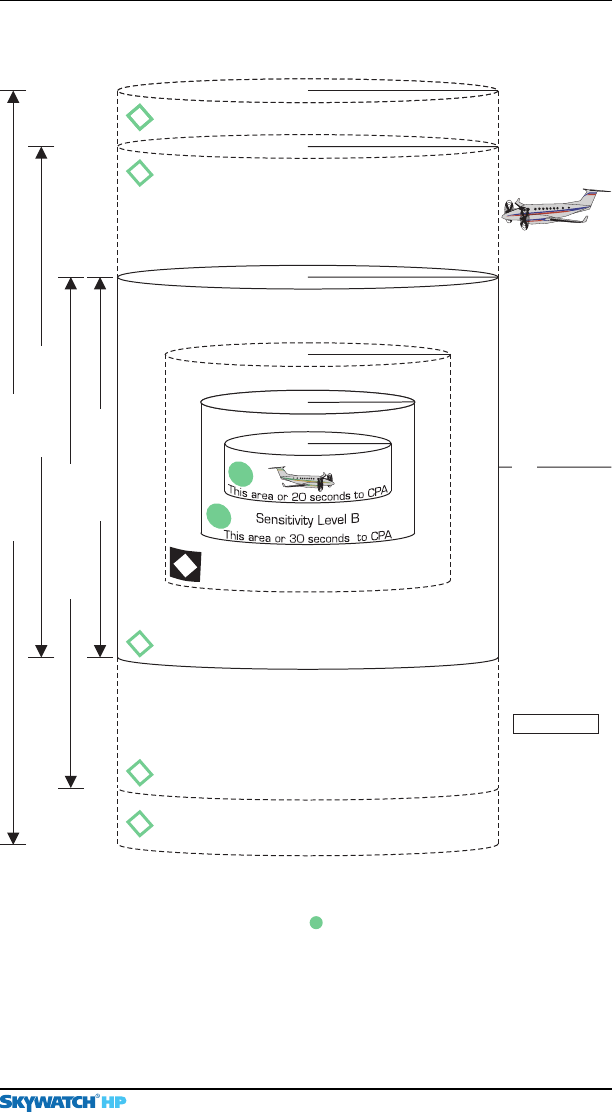
Chapter 1 – System Description
SKY899 Pilot’s Guide 1-7
Preliminary
Traffic Zones Diagram
Figure 1-5. Vertical Display Modes and Traffic Zones
0.2 nmi
0.55 nmi
15 nmi
+2700 ft
–2700 ft
+9000 ft
+9900 ft
Intruder Aircraft
–9000 ft
–9900 ft
*15 seconds for non-altitude reporting intruder aircraft
Not To Scale
+800 ft
+1200 ft
–800 ft
–1200 ft
+600 ft
–600 ft
15 nmi
15 nmi
Sensitivity LevelA
Look Down (BLW)
Look Up (ABV)
Normal (NRM)
0 ft
**20 seconds for non-altitude reporting intruder aircraft
Refer to chapter 4 for details.
*
**
Unrestricted (UNR)
+9900 ft
15 nmi
CPA – Closest Point of Approach PA – Proximity Advisory
OT – Other Traffic – Traffic Advisory
4 nmi
(
PA–
n
o
TC
ASonly)
(T
O
)
(T
O
)
(T
O
)
(OT)
(OT)

Chapter 1 – System Description
SKY899 Pilot’s Guide
1-8
Preliminary
•Performs automatic and operator-initiated self tests
•Offers a high-resolution, green monochrome, CRT display for
TAS installations
•Transmits interrogations from the ground (if desired) as well
as from the air
•Shares a display with the Stormscope WX-1000 (if desired)
when the SKY899 is installed as a TAS
•Switches to the SKYWATCH screen from the optional
Stormscope screen automatically when a TA occurs
•Uses only one antenna
•Eases installation since the standard TAS display fits in a 3-ATI
cutout in the cockpit panel
•Displays traffic on a variety of displays
•Uses information from ADS-B broadcasts (if available) along
with own aircraft GPS nav data to enhance intruder location
computation
Features
Features – Continued
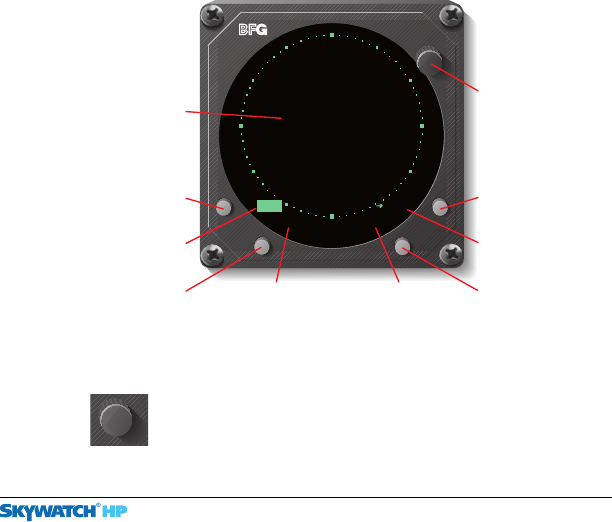
SKY899 Pilot’s Guide 2-1
Preliminary
Controls &
Indicators
Chapter 2
Introduction
This chapter describes the SKY899 controls and indicators
including the controls, indicators, and symbols on the display,
discrete controls and indicators, and aural announcements.
Controls, Indicators, & Symbols
Figures 2-1 and 2-2 and the following paragraphs describe the
SKY899 controls, indicators, and symbols.
Figure 2-1. Controls & Screen Elements in Standby
BRT
OFF
Power/
Brightness
Control Knob
Standby
Indicator
Message
Button
Message
Indicator
Operating
Mode Button
Label for Op
Mode Button
Test
Button
Label for
Test Button
Display Range
Indicator
Display Range
Button
OPRMSG
Standby
SKY899
TEST 6nm
Power/Brightness Control Knob (OFF/BRT)
This knob controls power to the SKY899 and WX-1000
(if installed) and adjusts display brightness.
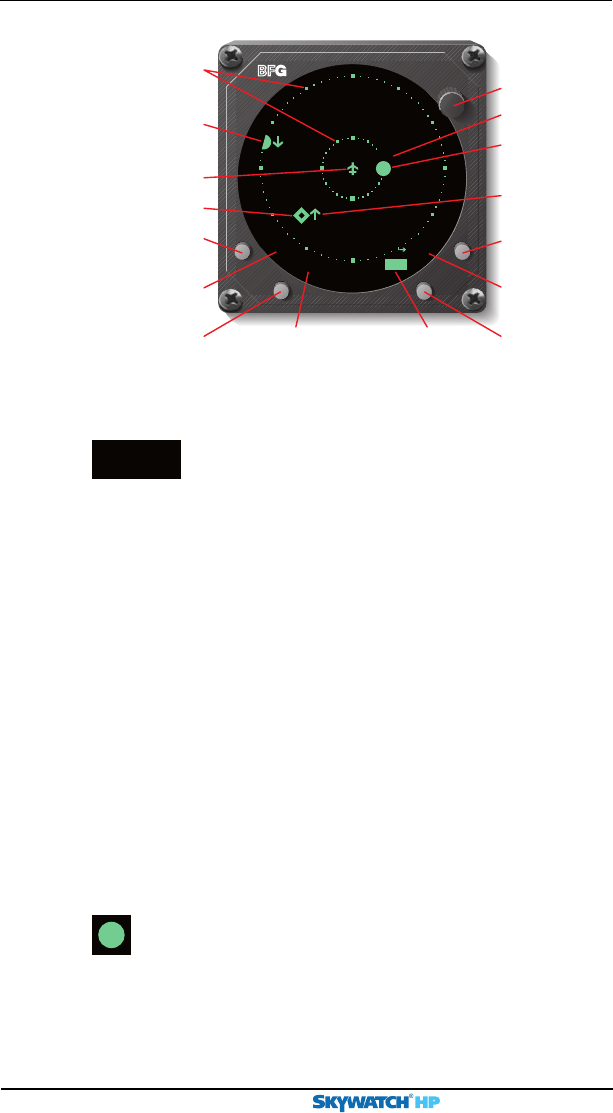
Chapter 2 – Controls & Indicators
SKY899 Pilot’s Guide
2-2
Preliminary
Data Tag These two digits indicate, in hun-
dreds of feet, the relative altitude of the intruder
aircraft. In this case, +04 means the intruder
aircraft is 400 feet above you. A positive data tag is
displayed above the traffic symbol to emphasize
that the intruder aircraft is above your aircraft.
Similarly, a negative data tag is displayed below
the traffic symbol. If the intruder is at the same
altitude as your aircraft, 00 is displayed above the
traffic symbol.
The data tag for a vertically out of range TA stays
at the maximum or minimum relative altitude
number of the current vertical display mode until
the intruder aircraft comes within the relative
altitude limits of the vertical display mode. The
SKY899 only displays data tags for altitude report-
ing aircraft. Non-altitude-reporting aircraft are
considered to be at the same altitude as your awn
aircraft.
Traffic Advisory (TA) A TA consists of a symbol on-
screen and a “traffic, traffic” message on the cockpit
speakers or headset. When an intruder aircraft that meets
the TA criteria described in chapter 4 is within the
displayed range (inside or outside of the selected vertical
display mode), the corresponding symbol is this circle
On-Screen Elements
+04
Figure 2-2. Controls & Screen Elements in Operating Mode
BRT
OFF
UNR
STBMSG
6nm
+10
+04
+05
Power/
Brightness
Control Knob
Range
Rings
Off-Screen
TA)
Traffic
Advisory (
Own Aircraft
Other Traffic
Message
Button
Message
Indicator
Traffic
Advisory (TA)
Vertical
Trend Arrow
Data Tag
Operating
Mode Button
Label for Op
Mode Button
Vertical
Display Mode
Button
Vertical
Display Mode
Indicator
Display
Range
Indicator
Display
Range
Button
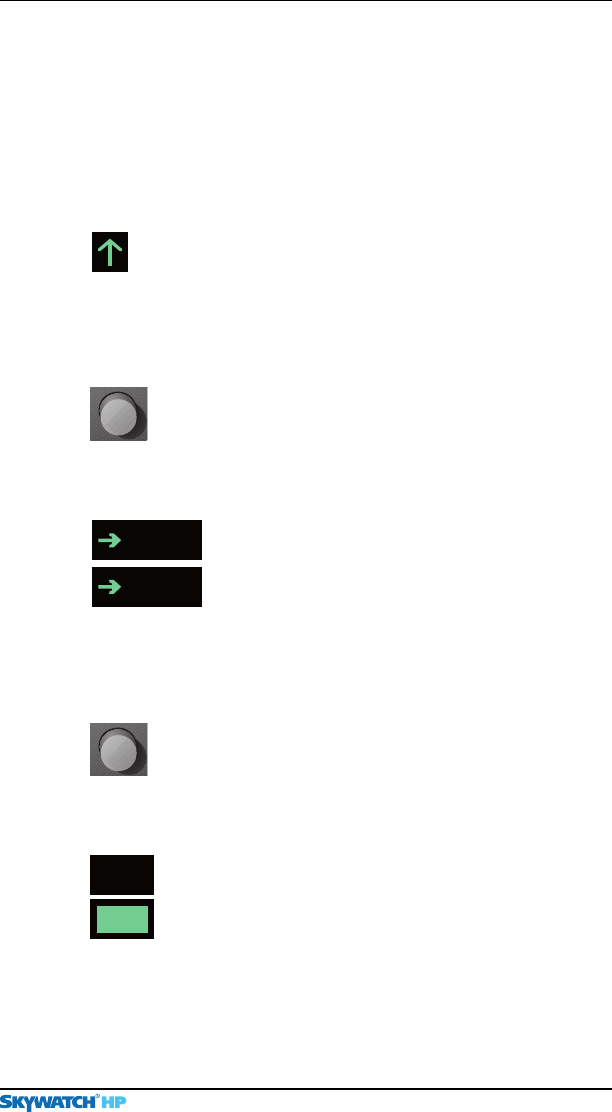
Chapter 2 – Controls & Indicators
SKY899 Pilot’s Guide 2-3
Preliminary
located at a position on the screen that indicates the
relative bearing and range of the intruder aircraft.
In general, the SKY899 issues a TA when it detects an
intruder aircraft within 30 seconds of a possible collision,
or within a 0.55 nmi horizontal radius and a ±800 ft
relative altitude range of your aircraft. (See chapter 4 for
details.)
Vertical Trend Arrow A vertical trend arrow
indicates that the intruder aircraft is ascending (up
arrow) or descending (down arrow) faster than 500 fpm.
No arrow is shown for intruder aircraft in level flight, or
for those moving vertically slower than 500 fpm, or for
non-altitude-reporting intruder aircraft.
Operating Mode Button Pressing this button
when it’s labeled >STB switches the SKY899 out of
normal operating mode and into standby. Pressing the
button when it’s labeled >OPR switches the SKY899
out of standby and into normal operating mode.
Label for Operating Mode Button This
on-screen label identifies the function of the
adjacent button. The >STB label appears on the
traffic screen and means go to standby. The
>OPR label appears on the standby screen and
means go to normal operating mode. If your
aircraft has a squat switch, the >STB label only
appears when your aircraft is on the ground.
Display Range Button Pressing this button when
the SKY899 is in standby has no effect. Pressing the
button when the SKY899 is in operating mode toggles
the SKY899 display range between 15, 6, and 2 nmi as
reflected in the on-screen display range indicator.
Display Range Indicator The unhighlighted
version of the indicator (present only on the Standby
screen) simply reminds you that the adjacent button
can be used to select the display range once you
switch into operating mode. The highlighted version
of the indicator (present only in operating mode)
identifies the currently selected display range (15, 6, or
2 nmi).
Buttons & On-Screen Elements
STB
6nm
OPR
6nm
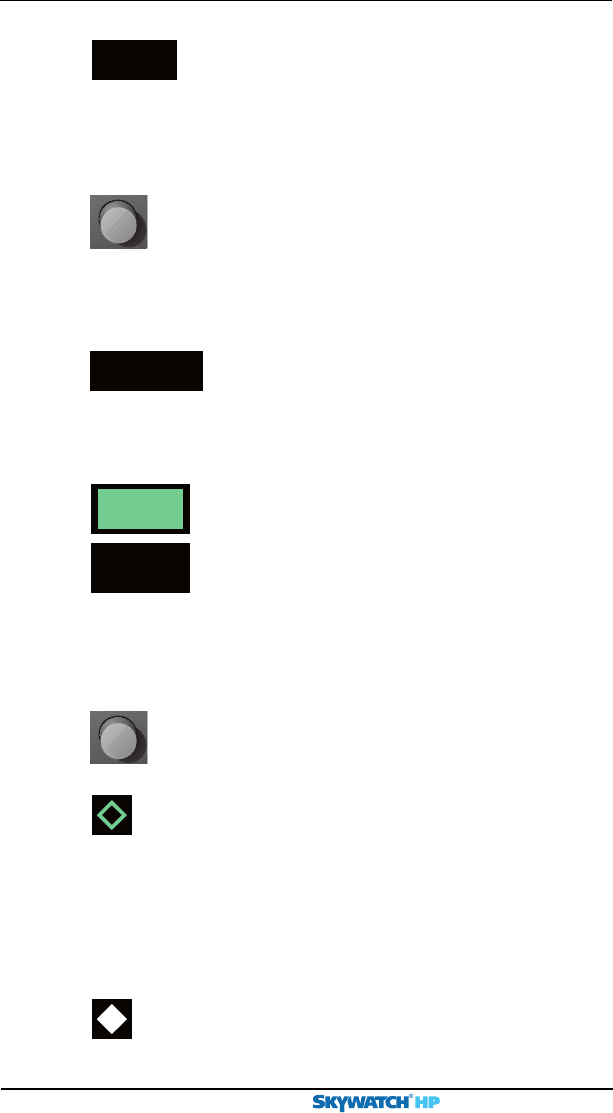
Chapter 2 – Controls & Indicators
SKY899 Pilot’s Guide
2-4
Preliminary
Buttons & On-Screen Elements
Vertical Display Mode Indicator This
indicator displays the name of the currently
selected vertical display mode: ABV (above/look
up), BLW (below/look down), NRM (normal), or
UNR (unrestricted). The indicator does not appear
when the SKY899 is in standby.
Vertical Display Mode Button/Test Button
In operating mode, this button changes the SKY899
vertical display mode between above, normal, below,
and unrestricted as reflected in the on-screen vertical
display mode indicator. In standby, this button starts a
self test.
Label for Test Button This on-screen
label only appears when the SKY899 is in
standby or in failed mode. It identifies the
function of the adjacent button which is to start
the operator-initiated self test.
Message Indicator The highlighted version
of this indicator appears when there is a new
message. The indicator switches to the
unhighlighted version when all the messages have
been read. In operating and failed modes, the
unhighlighted version disappears when the
messages disappear, but in standby, the
unhighlighted version remains on the screen even
if there are no messages.
Message Button When the message indicator is
present, pressing this button displays the message
screen.
Other Traffic (OT) On the WX-1000/SKY497 display,
this symbol represents an intruder aircraft that has been
detected within the selected display range and vertical
display mode, but which has not generated a TA. On
alternate displays, this symbol represents an intruder
aircraft that has been detected within the selected display
range and vertical display mode, but which does not
generate a TA or a PA.
Proximity Advisory (PA) (not shown) This
symbol only appears on TCAS installations. A PA
MSG
MSG
TEST
UNR
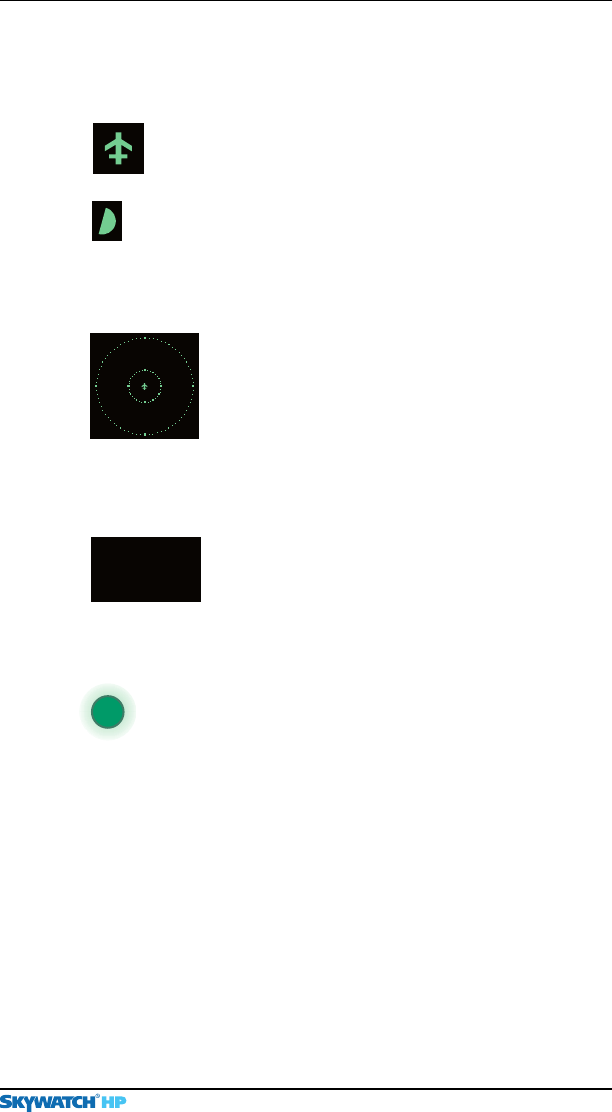
Chapter 2 – Controls & Indicators
SKY899 Pilot’s Guide 2-5
Preliminary
for Stormscope
represents an intruder aircraft that does not generate a
TA, but which is within a horizontal range of 4 nmi and
a relative altitude of ±1200 ft.
Own Aircraft This symbol represents your aircraft’s
relative position and heading.
Off-Screen Traffic Advisory (TA) This symbol
represents a TA that has been detected beyond the
current display range. The symbol is displayed at a
position along the outer range ring that indicates the
relative bearing of the intruder aircraft.
Range Rings The outer range ring represents
a distance of 15, 6, or 2 nmi from your aircraft
corresponding to the selected display range as
indicated in the display range indicator. The
inner range ring on the 15 nmi range represents
a distance of 6 nmi. The inner range ring on the
6 nmi range represents a distance of 2 nmi.
There is no inner range ring on the 2 nmi range.
Standby Indicator This indicator is
displayed as long as the SKY899 is in standby
except when the test screen is displayed during
an operator-initiated self test. In standby, the
SKY899 does not interrogate, process, or display
traffic.
Operate Lamp (optional, not supplied) This
panel-mounted indicator light is lit whenever the SKY899
is sending out interrogations. The light is not lit in
standby or when the unit is in failed mode.
Controls Required for the
Stormscope
Option
SKYWATCH/
Stormscope
Mode Switch (not supplied)
This panel-mounted toggle switch determines whether traffic
information or thunderstorm information is displayed.
The SKY899 and the WX-1000 continue tracking even if the
switch is in the other position. If the SKY899 detects a TA or
generates an error message when the switch is in the Stormscope
position, the display switches to the traffic screen to display the
TA or the error message.
Standby
SKY899
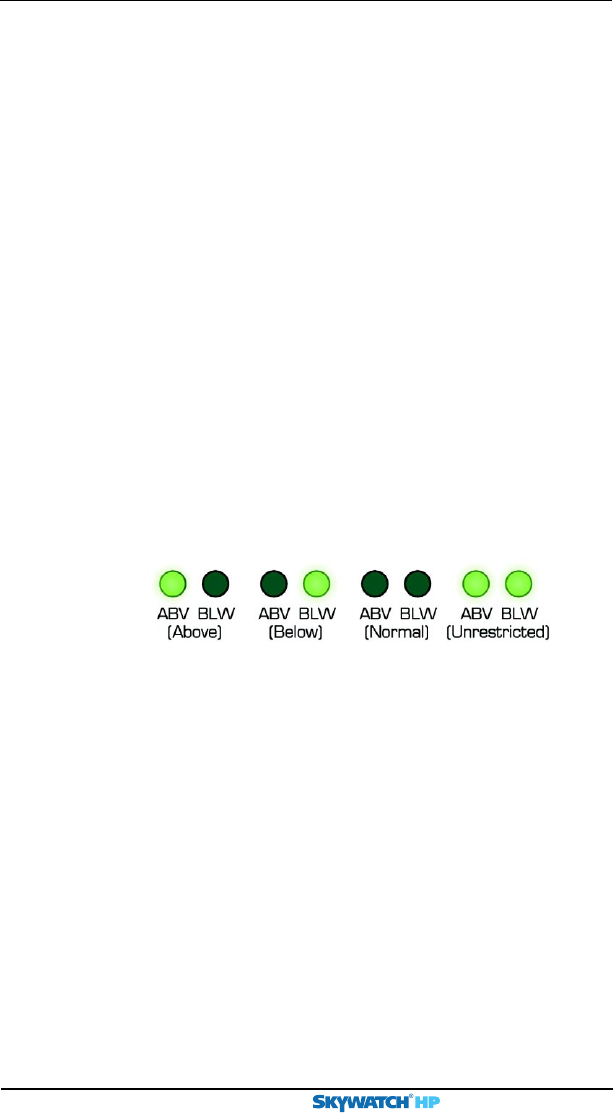
Chapter 2 – Controls & Indicators
SKY899 Pilot’s Guide
2-6
Preliminary
Alternate Display & Aural Announcements
WX-1000 Maintenance Switch (not supplied) This
remote toggle switch (normally installed in the avionics bay
near the WX-1000 processor) has a Normal position and an
Override (WX-1000 maintenance) position. It should only be
moved to the Override position when the WX-1000 processor is
removed or powered down at the circuit breaker, and you still
want to use the SKY899.
Controls & Indicators for an Alternate Display
Control Panel (not supplied) A discrete control panel pro-
vides the functions normally provided by the buttons and knob
on the WX-1000/SKY497 display. These functions include
controlling power to the SKY899, selecting the display range,
selecting the vertical display mode, selecting the operating
mode, and starting the self test.
Vertical Display Mode Indicator Lamps (not supplied)
Some alternate displays do not display a vertical display mode
indicator on-screen. For those displays, two discrete indicator
lamps similar to those shown in figure 2-3 indicate the current
vertical display mode.
Aural Announcements
“Traffic, Traffic” This aural component of a traffic advisory
is announced once over the cockpit speakers or headset when a
TA is first detected.
“SKYWATCH System Test Passed” This message is
announced once over the cockpit speakers or headset after the
SKY899 has passed an operator-initiated self test.
“SKYWATCH System Test Failed” This message is
announced once over the cockpit speakers or headset after the
SKY899 has failed an operator-initiated self test.
Figure 2-3. Vertical Display Mode Indicator Lamps
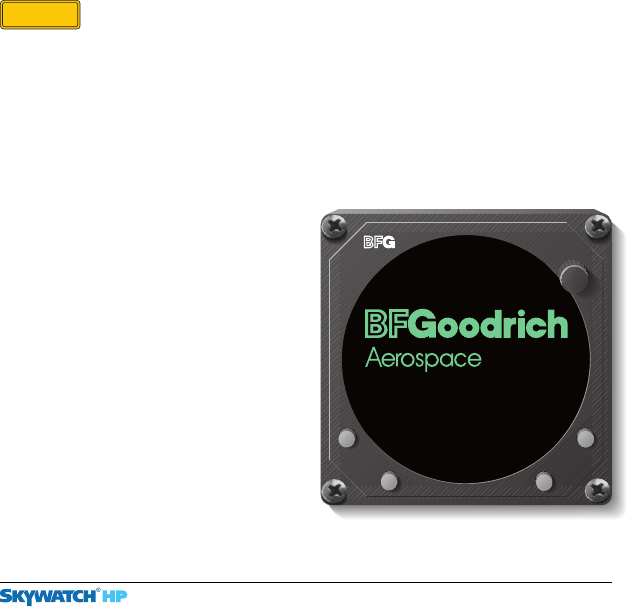
SKY899 Pilot’s Guide 3-1
Preliminary
Operating
Instructions
Chapter 3
Introduction
This chapter lists the SKY899 operating instructions and
describes its fault modes.
Turn On the SKY899
To avoid power surges that could damage the SKY899 and the
optional WX-1000, start your engines before turning on the SKY899.
1. Turn the
OFF/BRT
knob clockwise to the desired display
brightness.
The BFGoodrich screen (figure 3-1) appears and stays on the
display until the power-on self test is complete.
If the SKY899 passes the test, and your aircraft has a squat
switch, and your air-
craft is on the ground,
the standby screen
appears (figure 3-2).
If the SKY899 passes
the test, and your
aircraft has a squat
switch, and your air-
craft is in the air, the
traffic screen appears
set on the 6 nmi
display range and the
normal vertical display
mode (figure 3-3).
CAUTION
Figure 3-1. BFGoodrich Screen
BRT
OFF
BFGoodrich Avionics Systems,Inc.
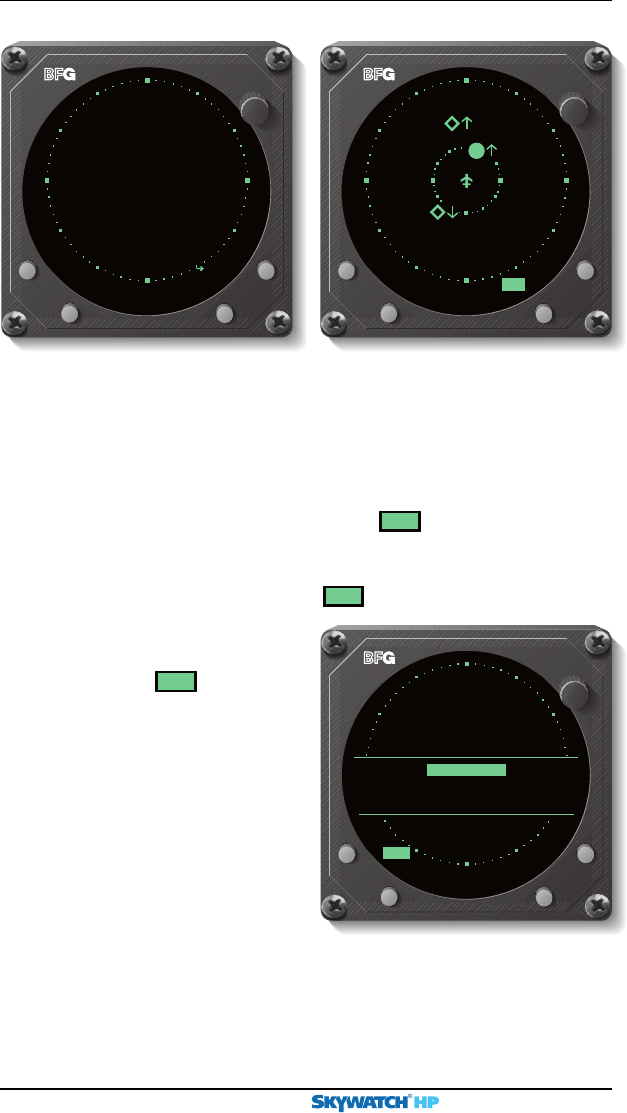
Chapter 3 – Operating Instructions
SKY899 Pilot’s Guide
3-2
Preliminary
If the SKY899 passes the test and your aircraft does not have a
squat switch, the standby screen (figure 3-2) appears.
In standby, the SKY899 waits 5 minutes for critical sensors such
as the barometric altimeter to warm up and come on line
before it displays a Failed screen or
MSG
due to the lack of the
sensor input; however, if you switch into operating mode, the
SKY899 only waits 2 seconds for the sensor inputs before it
displays the Failed screen or
MSG
.
If a Failed screen similar
to figure 3-4 appears, or if
you see
MSG
, refer to the
Message Response section
on page 3-7. For installa-
tions with an ARINC 429
barometric altitude input,
turning on the SKY899
during flight causes a
temporary Error 20
message while the system
is syncing up to the 429
data source.
Turn on the SKY899
Figure 3-3. In-Flight Traffic Screen
Figure 3-2. Standby Screen
BRT
OFF
OPRMSG
Standby
SKY899
TEST
6nm
BRT
OFF
NRM 6nm
-26
+10
-02
Figure 3-4. Failed Screen
Failed
SKY899
TEST
BRT
OFF
Barometric Input Error
Error 20
MSG
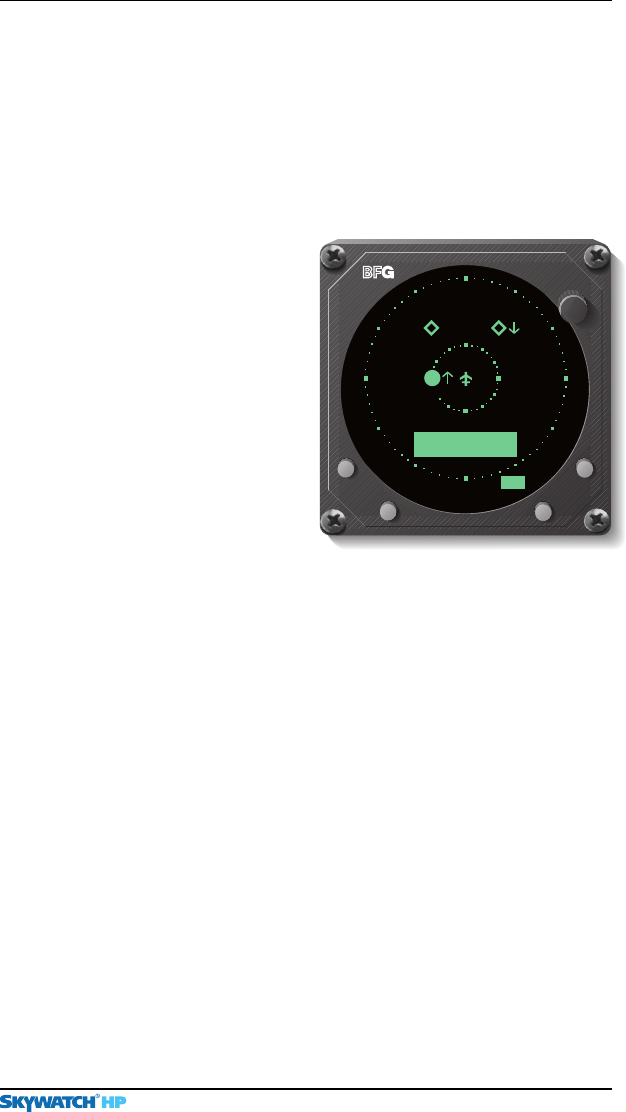
Chapter 3 – Operating Instructions
SKY899 Pilot’s Guide 3-3
Preliminary
Run the Self Test
Run the Operator-Initiated Self Test
It is recommended, but not required that you should run the
operator-initiated self test before the first flight of the day (or as
specified in your Aircraft Flight Manual [AFM]), and whenever
you get a Failed screen.
1. With the
SKY899
in standby or failed mode, press the
TEST
button.
The SKY899 begins its
self test and the test
screen (figure 3-5)
appears. Upon
successful completion
of the self test, you
will hear “SKY-
WATCH System Test
Passed” and the
display will revert to
the previous standby
or traffic screen.
2. If you hear “
SKY-
WATCH
S
ystem
T
est
F
ailed” or see a
SKY899
F
ailed screen, push the
TEST
button
again. If it fails again, refer to the
M
essage
R
esponse section
on page
3-7
.
3. If you hear “
SKYWATCH
S
ystem
T
est
P
assed” without seeing
the test screen, and the
OFF/BRT
knob is turned to
BRT
, turn
off the
SKY899
and contact your authorized
BFG
oodrich
A
vionics
S
ystems dealer for troubleshooting help.
Switch Between Standby & Normal Operating Mode
When you’re on the ground, you must manually switch out of
standby if you want the SKY899 to display traffic information.
The ability to switch out of standby on the ground in conjunc-
tion with the above display mode is especially useful for
scanning the airspace around the airport before takeoff.
1. To manually switch into normal operating mode from the
standby screen (figure
3-2
), press the button labeled >>
>>
>
OPR
.
Figure 3-5. Test Screen
6nm
NRM
SYSTEM TE ST
IN PROGRESS
-10
+10
-02
BRT
OFF
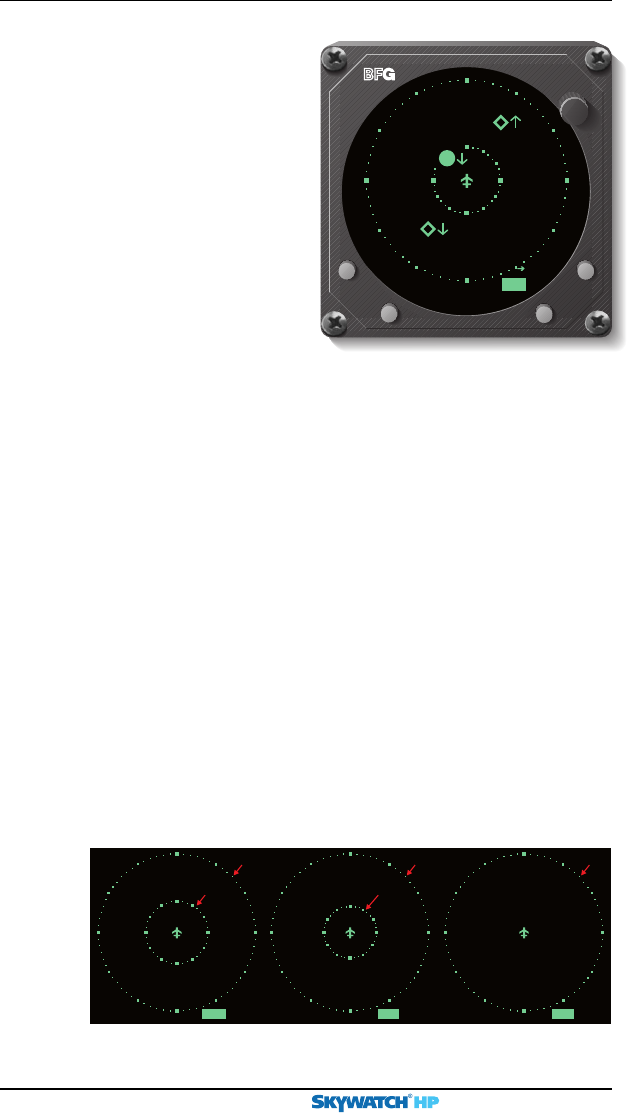
Chapter 3 – Operating Instructions
SKY899 Pilot’s Guide
3-4
Preliminary
The SKY899 switches
out of standby into
the above display
mode and 6 nmi
range (figure 3-6).
If your aircraft has a
squat switch and you
don’t manually switch
out of standby, the
SKY899 automatically
switches out of
standby 8 to 10
seconds after takeoff.
2. To manually switch
into standby from the traffic screen, press the button
labeled >>
>>
>
STB
.
The SKY899 goes into standby and the display switches back
to the standby screen. (If your aircraft has a squat switch, the
>STB button label is not displayed while airborne, and the
SKY899 will not go into standby while airborne.)
If your aircraft has a squat switch, the SKY899 also goes into
standby automatically, 24 seconds after landing. This delay
allows the SKY899 to remain out of standby during a touch-
and-go maneuver.
Change the Display Range
You can change the display range when the SKY899 is in normal
operating mode.
1. Press the display range button to toggle the display range
between
15
,
6
, and
2
nmi (figure
3-7
).
15nm 6nm 2nm
6 nmi 2 nmi
15 nmi 6 nmi 2 nmi
Figure 3-7. Display Ranges
Change the Display Range
Figure 3-6.Traffic Screen on the
Ground
BRT
OFF
ABV 6nm
+94
+10
+04
STB